Australia’s resource dependent economy relies on rail transport, so the engineering skills to design, construct and maintain rail infrastructure are crucial.
The below article was first published by Create Digital on 13 October 2021.
To understand the future of the rail industry you have to understand its past, says lecturer at the University of Tasmania, Dr Martin Murray CPEng.
“The rail industry has been cyclic over the past 30 years,” he says. “Before that, rail authorities were state owned. They were stable. Engineers stayed for their careers, holding on to all of that knowledge, experience and typically with excellent training and development.”
The argument for moving on from a state-owned model was that it was inefficient. However, as a result of privatisation, downsizing and a profit motivation, a lot of institutional knowledge in rail engineering was lost. For example, Queensland Rail headcount fell from around 25,000 staff to less than 10,000 staff, says Murray. Other low-hanging organisational expenses also began to disappear.
“Development programs were cut off. They were an easy way to save money,” he says. “A lot of technical expertise was pared down dramatically.”
Consultants and contractors filled some shortages, but they were not trained and developed as regularly and thoroughly as engineers had been in the public sector. That left a major skills gap, one that still exists today.
“Back in 2016/17, Transport for NSW realised there were limited options to train civil engineers [in rail],” Murray says. “They put feelers out, along the way approaching Engineering Education Australia (EEA) to set up a course.”
EEA won the contract and partnered with the University of Tasmania to set up the Diploma in Engineering Infrastructure (Rail), which is what Murray and his colleagues work on now.
It’s difficult to do meaningful workforce planning in a boom and bust environment, says Murray. So this diploma was designed to help streamline the talent supply by ensuring any engineer whose career might be connected to rail infrastructure has access to a cutting-edge education program.
“Right now in terms of rail demand we’re in a hiatus,” he says. “We’ve had a boom, now things are evening out, but there are huge investments planned by state governments to get economies going after the pandemic. There is a lot of money going into rail right now, and a lot more planned.”
What’s driving rail demand?
Rail is crucial to Australia’s economy, delivering much of the country’s resources sector’s products, particularly iron ore and coal, to ports for export. With the opportunities that come from this, many engineering organisations are realising their people could be better educated around rail.
“It’s very difficult to get people up to speed quickly, so that is a major driver of this course – to upskill the current engineering workforce,” says Murray.
“When Transport for NSW funded the course for their people, they were very happy with the outcome. That triggered a lot more interest from across the country in the diploma. The output is an engineer who satisfies the current and future needs of their employer much better, and who will therefore progress through the organisation and industry more quickly.”
There are currently 110 students enrolled in the course, which is delivered by the University of Tasmania in partnership with EEA and Transport for NSW. Another 25 to 40 students enter at the beginning of each semester.
“The testimonials we receive from our students while they’re doing the course tell us how relevant and powerful the course is,” Murray says. “The assignments, projects and case studies frequently apply to the work they’re doing in their professional lives and workplaces.
The relevancy of the course was of paramount importance because the industry itself drove it into existence, says Murray.
“To get it started, we had a number of industry roundtables and developed and produced what the industry wanted. We’re satisfying the needs of industry in a course that will only become more important.”
Even though Australia’s railways can be considered a small player in the transport field in terms of total trips when compared with road and air, says Murray, it is a major powerhouse if you take into account its influence on the national economy.
“Without railways, we wouldn’t be able to export hundreds of millions of tons of resources,” says Murray. “We wouldn’t earn billions of export dollars. So yes, it’s a smaller industry, but it has an impact way beyond its size.”
Find out more about the Diploma in Engineering Infrastructure (Rail).
